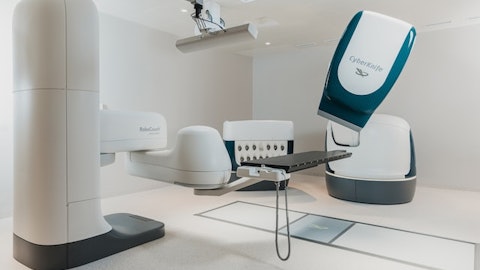Kyle Mikson: Yes. That was perfect. Again, thanks so much guys for all the commentary.
Dr. Lishan Aklog: I just want to emphasize — I just want to reiterate one other thing. So the test is not similar. It’s the same test. The same test just better in terms of efficiencies. And so just to be clear, the underlying biology is identical to the original test. Just wanted to make sure that there was no confusion about that.
Operator: Our next question comes from Ross Osborn with Cantor Fitzgerald.
Ross Cantor: You mentioned targeting police officers for new pre-cancer detection events. Would you discuss the rationale for this population and if you plan to create a registry from these events similar to firefighters?
Dr. Lishan Aklog: Yes. No, I think the expansion beyond firefighters into other groups is really I would think of it more generically as opposed to policemen being — having sort of unique risk factors associated with it. It really is a population. If you look at the risk factors for having esophageal pre-cancer, yes, there’s a reasonably high incidence amongst them, but not because of any particular occupational exposure as opposed to in firefighters where it’s really very well documented that they have increased cancer rates in general and the second highest increase in that cancer rate and those cancer rates is amongst esophageal cancer. So a good opportunity for me to emphasize that we remain very focused on firefighters as a specific population.
That’s why we’ve split our registry to include a dedicated subset of firefighters. I would view the police as basically just a broader expansion of our finding sort of a captive audience, a group that has a reasonably — a reasonable rate of having the risk factors and being good candidates for testing and having them aggregated in entities such as place unions that will — that give us an opportunity to target a larger group at once and to improve access. And so we’ll continue to expand these CYFT events into other groups. There’s public service employees, and it really starts to kind of meld into the broader direct contracting initiative that we’re just getting off the ground with our first employer. So if you think of employers as self-insured entities, unions, they really are sort of part of the same spectrum of just collected groups of patients where we have potential for high-yield events such as our CYFT events.
The firefighters are special in that they have a clear elevated risk and require and justify a targeted focus. Does that make sense?
Ross Cantor: Yes, makes perfect sense. And going off of that, and apologies if this was addressed in your prepared remarks or in a couple of calls. But would you discuss how your conversations going with additional employers for Direct Contracting? Do you think it should be a key driver for ’24?
Dr. Lishan Aklog: I think it should. The conversations we’ve had and the conversations we had with our first employer contract, the ones that are undergoing testing right now this quarter as we speak. It’s really interesting. There’s a sort of a sweet spot of kind of small to medium employers who are self-employed where one esophageal cancer patients amongst them or one cancer, other kind of cancer can have a really big impact both economically, if they’re self-insured, they have some reinsurance and other opportunities to cover that. But right now, esophageal cancer diagnosis will typically cost about $1 million or more once you get through all the surgery and chemo and radiation and immunotherapy. And so there’s a strong economic argument to be made for these particularly for the smaller to medium companies.
There’s also a human element there, where these tend to be close knit organizations and the impact of cancer or cancer death within that organization is really meaningful on a human level. And so our ability to have these conversations into — and there’s a real motivation on leadership at these employers to provide their patients with something that they would deem to be a real benefit to them. The whole area of offering testing as part of a broader health and wellness benefit program sort of separate from your medical insurance, coverage under your medical insurance through standard claims process is really a blue ocean. It’s something that other companies, other diagnostic companies have had good success with. And there’s a whole sort of untapped ecosystem out there that we are about to really dive headfirst with [Jim Fraccione], our new VP of Employer Markets of working within the ecosystem of brokers and others that work with employers to get their health and wellness benefit programs packaged together.
You think of that more along things like smoke and cessation and nutrition and other things, add-on things that are benefits that employers can offer their employees, but targeted testing, and particularly testing that’s designed to prevent cancer falls within the same rubric there. So super excited. These — there’s a cyclical nature of this. They tend to peak around open enrollment periods, but there is a lot of opportunity there and an opportunity that supplements and in some ways, short circuit some of the even more traditional routes going through payers. So yes, super excited about diving forward into this.
Operator: Our next question comes from Mike Matson with Needham & Co.
Mike Matson: I guess I wanted to ask about, Dennis, just given the trends you’re seeing with the revenue cycle management, collections and so forth. Do you have any feel for our ability to predict when you could maybe start to recognize revenue when the tests are actually performed as opposed to when we get paid for them?
